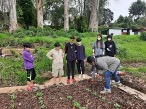In March 2022, the KIS Center for Environment and Humanity submitted a grant proposal to Kodai Friends International to support the establishment of a Seed Bank, Nursery, and Food Forest on the CEH campus (former Swedish school) over the course of 3 years. The objectives of this project are:
- to raise awareness about the threatened biodiversity of the Palani Hills
- to provide experiential learning opportunities for KIS, local, and international visiting students on biodiversity conservation and its intersection with land use and modern agriculture
- and, to practice sustainable land management, regenerative agriculture, and biodiversity conservation within our campus.
Summary of Activities:
Thanks to funding from Kodai Friends International for Year 1 of the project, CEH gathered environmental expertise to develop a regenerative agriculture based landscape design for the 2-acre property. While the landscape design was in progress, CEH began cultivation on a small area of the campus to experiment on sustainable farming techniques with students and local farmers. CEH also started a small Shola Nursery for saplings to be planted within the CEH and other KIS campuses. Finally, CEH integrated this project and the concept of Regenerative Agriculture into the KIS Ecoclub for students grade 9-12. This project served as a platform for KIS students to understand agriculture practices in Kodaikanal through field trips and interactions with farmers in villages such as Poombarai, Prakashapuram, Pallangi-Kombai, and Vilpatti. Students also worked to develop the cultivation zone on the CEH campus, where they planted legumes, vegetables, herbs, and flowers. It was a challenge to use only organic and regenerative agriculture principles on our land, but this exercise helped students internalize the difficulties that farmers face in producing food at a large scale. Through the KIS Ecoclub and this Food Forest project at CEH, we encourage all students to think about the future agriculture, and how it can be improved by making food systems more efficient, inclusive, and resilient, while ensuring a sustainable natural resource base.
Expansion of Project in 2023-24: Funding for Year 1 of the Food Forest Project Proposal submitted in March 2022 was crucial in boosting CEH’s activities and direction toward sustainable land management and regenerative agriculture. Throughout our activities in Year 1, we learned that the project has scope to be much larger than a food forest, Shola nursery, and seed bank. We seek to expand the project to the entire campus to offer an immersive learning experience on the intersection between agriculture and biodiversity. The outdoor space will be divided into different zones according to regenerative agriculture objectives, with a trail connecting various zones to facilitate campus tours. The journey will highlight sustainable farming, ecosystem services, climate resilience, carbon sequestration, soil and water management, and self-sustenance. CEH now has a detailed design for the entire property to help visitors understand concepts of a food forest, sustainable land use, and backyard biodiversity conservation within the context of the Palani Hills. Local residents, school students in Kodaikanal and abroad, and tourists will leave CEH with the knowledge, tools, and inspiration to implement principles of regenerative agriculture wherever they go.
Spending Summary:
In Year 1, CEH focused on preparing the land, collecting all the basic tools and equipment required to set up a food forest, and gathered information from environmental experts to plan and design the 2-acre property. 62% of the Year 1 funds were used toward environmental expertise to put together a detailed landscaping plan and of the CEH outdoor space. Due to unmet expectations of a consultant hired in June 2022, the project was recommissioned to environmental experts in permaculture and wild-scaping design – this resulted in an additional 1 Lakh Rupees spent on environmental expertise. Maintenance of the pear orchard, vegetable beds, nursery, and shola forest zone require consistent operational labor – 29% of Year 1 funds were used for landscaping and seasonal operations. Finally, CEH did not build a greenhouse in Year 1 as planned. Instead, we used the greenhouse as a hands-on learning opportunity for students to construct one on their own using bamboo. This bamboo greenhouse will be used for ornamental plants. CEH will build a larger greenhouse for summer crops such as cucumber, tomatoes, chilies, bell peppers, and eggplant in Year 2.
Year 1 Spending Categories and Balance:
| Item | Amount Budgeted (INR) | Amount
Debited (INR) |
Balance
(INR) |
| Maintenance and Operations | 438,000 | 218,536 | 219,464 |
| Tools and Input Materials | 385,000 | 68,867 | 316,133 |
| Environmental Expertise | 360,000 | 461,000 | -101,000 |
| Total (INR) | 1,183,000 | 748,403 | 434,597 |
| Total (USD) | 15,270 | 9,132 | 5,303 |


